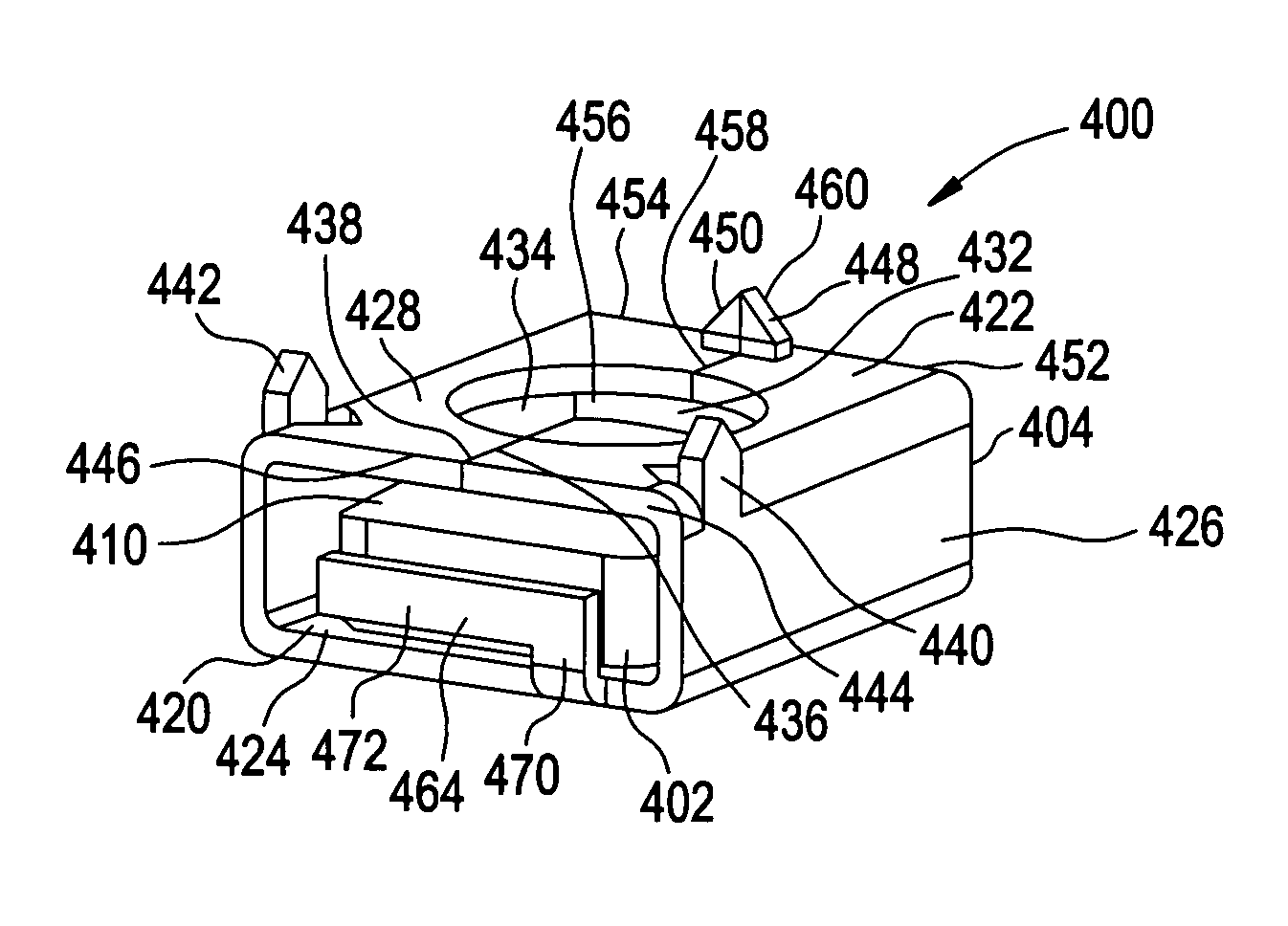Split weld cage nut assembly
a cage nut and weld technology, applied in the direction of threaded fasteners, screws, fastening means, etc., can solve the problem that the cage nut assembly generally has a large thickness of the cage wall, and achieve the effect of thin wall thickness
- Summary
- Abstract
- Description
- Claims
- Application Information
AI Technical Summary
Benefits of technology
Problems solved by technology
Method used
Image
Examples
second embodiment
[0039]Attention is now directed to FIGS. 1–3 which illustrate a cage nut assembly 100 which is in accordance with the present invention. The cage nut assembly 100 includes a nut member 102 and a cage member 104.
[0040]The nut member 102 is best illustrated in FIG. 3 and includes a rectangular block 106 having a generally planar upper surface 108, a generally planar lower surface 110 and sidewalls 112 which connect the upper and lower surfaces 108, 110. The nut member 102 also includes a cylindrical member 114 which extends outwardly from the upper surface 108 of the nut member 102. The cylindrical member 114 is preferably in the form of a right circular cylinder. An aperture 116 extends through the nut member 102 from the block 106 into the cylindrical member 114. The aperture 116 may be closed at the lower surface 110 of the block 106 or it may extend all the way through the block 106. The aperture 116 defines an aperture wall 118 which is preferably threaded and is capable of recei...
third embodiment
[0059]Attention is now directed to FIGS. 7–9 which illustrate a cage nut assembly 300 which is in accordance with the present invention. The cage nut assembly 300 includes a nut member 302 and a cage member 304.
[0060]The nut member 302 is best illustrated in FIG. 9 and includes a rectangular block 306 having a generally planar upper surface 308, a generally planar lower surface 310 and sidewalls 312 which connect the upper and lower surfaces 308, 310. An aperture 316 extends through the block 306 of the nut member 302. The aperture 316 may be closed at the lower surface 310 of the block 306 or it may extend all the way through the block 306. The aperture 316 defines an aperture wall 318 which is preferably threaded and is capable of receiving a bolt or screw (now shown) to be attached thereto.
[0061]The cage member 304 is best illustrated in FIGS. 7 and 8. The cage member 304 is used for encaging the nut member 302. Prior to encaging the nut member 302, the cage member 304 has genera...
fourth embodiment
[0071]Attention is now directed to FIGS. 10–12 which illustrate a cage nut assembly 400 which is in accordance with the present invention. The cage nut assembly 400 includes a nut member 402 and a cage member 404.
[0072]The nut member 402 is best illustrated in FIG. 12 and includes a rectangular. block 406 having a generally planar upper surface 408, a generally planar lower surface 410 and sidewalls 412 which connect the upper and lower surfaces 408, 410. The nut member 402 also includes a cylindrical member 414 which extends outwardly from the upper surface 408 of the nut member 402. The cylindrical member 414 is preferably in the form of a right circular cylinder. An aperture 416 extends through the nut member 402 from the block 406 into the cylindrical member 414. The aperture 416 may be closed at the lower surface 410 of the block 406 or it may extend all the way through the block 406. The aperture 416 defines an aperture wall 418 which is preferably threaded and is capable of r...
PUM
 Login to View More
Login to View More Abstract
Description
Claims
Application Information
 Login to View More
Login to View More - R&D
- Intellectual Property
- Life Sciences
- Materials
- Tech Scout
- Unparalleled Data Quality
- Higher Quality Content
- 60% Fewer Hallucinations
Browse by: Latest US Patents, China's latest patents, Technical Efficacy Thesaurus, Application Domain, Technology Topic, Popular Technical Reports.
© 2025 PatSnap. All rights reserved.Legal|Privacy policy|Modern Slavery Act Transparency Statement|Sitemap|About US| Contact US: help@patsnap.com



